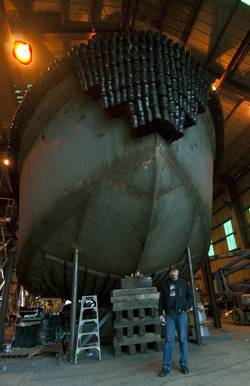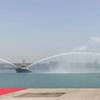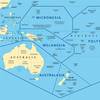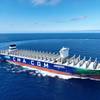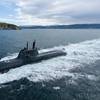When a Mariner Builds a Tug
Captain Jack Davies is the consummate boatman. Of himself he says, “I love running boats, and being involved in the marine industry.”
Davies wears a number of “hats” in the marine industry, and often he is aboard one of the tugs with which he has some ownership involvement. He can be found twisting wrenches in the engine room, working on deck, or in command on the bridge. Lately he has been overseeing the construction of his latest tug. The new McIlwain-designed Azimuthing Stern Drive (ASD) tug will be 64.75-feet in length, with a 27-foot beam. Of the relatively large beam for the length, Davies explains, “Adding beam is a way to improve the stability. Once a deck edge submerges, you start losing stability.”
With this much beam and 3.5-feet of freeboard on a hull depth of 17 feet and a draft of about 13.5 feet, this tug will have a lot of stability. The length and beam also give the boat a lot of floatation that has allowed Davies to specify all 1/2-inch steel throughout. Even the bulwarks are 1/2 inch with an additional 1/2-inch doubler on the hull where the Schuyler looped rubber fendering will be installed along the sheer strake and stern quarters. The bow will also have rubber extending along the bow stem to 8 feet below the water as, Davies explained, “Sometimes a pilot will ask you to get right on the bow stem and push, you cant always see or know how far below the water line the bulbous bow is.”
The attention to detail by an owner who is both an owner and an operator brings attention to details throughout the boat. From bulwarks designed for safe and easy deck work, to the extra hydraulic power to assure that the full 250-foot per minute recovery rate for the JonRie 200 series winch would be achieved. The bow mounted hawser winch has 175,000 pounds of braking power. More than enough for an estimated bollard pull of 50,000 pounds even allowing for greater forces when turning a ship. The winch drum will be loaded with 400-feet of 2.5-nch Spectra line. Ahead of the hawser winch is a 16-inch stainless, extra heavy wall, towing staple.
For a tug built to last like this one, flexibility is important so that it can work regardless of changing opportunities. At the moment it is contracted to join another McIlwain-designed tug, in which Davies has a half interest, as a ship-docking tug on Northern Vancouver Island. But he has designed it so that there is enough hydraulic power and after deck strength to take a towing winch should he choose to work the boat line-haul towing on the B.C. Coast. A pair of ballast tanks are built into the stern to provide the weight equivalent to the absent towing winch.
Canadian manning regulations vary according to the work that a tug is doing and the horsepower. At 148 gross tons the boat is under the 150-ton limit in Canadian regulations for this class of vessel. The accommodation area, in a raised fo’c’sle space that is just three steps down from the main deck, is another example of the tug’s flexibility. Roomy spaces for the galley on the port side and the mess to starboard can provide for up to six crew. All accommodation is above the waterline, and is “full floating” from the hull for noise reduction. Forward of the mess and galley are four large cabins. The aft two cabins are single berth officer cabins, and the two forward cabins are double berth, with the top bunk folding out of the way when not in use. All cabins are well appointed and have their own sink, and desk. The accommodation is also wired for television, internet, and telephone.
Working as a day-boat in ship docking the tug will require only two crew members. However crew size is also determined by horsepower, geographical area, and hours worked. In Canada a boat can operate without an engineer up to 1005 horsepower. Davies choose Cummins KTA38 M0 engines to drive his new ASD tug for their reputation and reliability, but also due to the practice in British Columbia of using them at variable horsepower. On several other tugs (see Cummins Hotips#324 Island Scout ) the engines have been installed with a governor switch that allows them to operate at 500 HP @ 1600 rpm or 850 HP at 1800 rpm. This means that when the larger power is not required the boat can operate without the required engineer. Add an engineer and unlock the switch the engine can operate at 850 HP and the boat will be towing at 1700 HP. Both ratings are conservative on this V-12 38-liter engine and will work well turning the 1.8-meter props though the HRP/ZF Z-drives.
The hull and decking of the new tug are all steel with the pilothouse fabricated from aluminum. The wheelhouse features huge windows above and forward for working ships and is equipped with a “u” shaped control console. The wheelhouse will also have a sink and coffee station so that there is no temptation to leave the bridge for a quick trip to the galley. In addition to the overhead glass, there is a topside command station with full controls, including the winch. With the bulwarks and raised foc’sle deck, visibility is restricted when you get close to something with low freeboard, Davies explained. “It is fine when working a ship but if coming alongside a buoy or other low object the visibility from the top of the house is better. This will be the first Z-drive on the B.C. coast with top controls.”
“I can’t say enough about the quality and craftsmanship of the crew at ABD,” enthused Davies. “I went over the drawings with Al Dawson and his partner Burton Drody for the costing, and then Burton prepared the CAD work for the steel cutting. The whole side of the hull above the double chine is formed from only two sheets of steel with one more wrapped around the bow. Everything fit perfectly the first time they put it up. I have inspected every bit of this boat as it was built. When I crawl through a fuel tank after the quality assurance person, I am unable to point out any deficiencies.” Davies is also a business man and his final note of praise for the shipyard, which is due to deliver his tug in the new year, is, “Quality Canadian construction, on time and on budget.”



